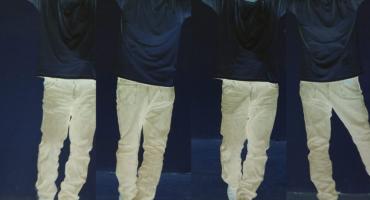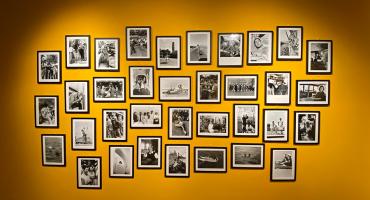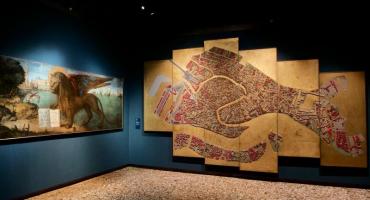Each type of craft used to get built
taking into account the need imposed by the structure of canals and their
twisting and turnings, together with the dangers of shallow water. The absence
of keel and rudder made the boats, from the flat bottom, able to be manoeuvred
by the means of only one oar, by a boatman that stands up aft. This
characteristic use of an oar belongs to so-called “voga alla veneta” (Venetian style rowing). This type of rowing is
peculiar in all the Venetian boats, that can boast of having a very unique type
of poppet called “forcola” (crutch) in Venetian. A “crutch” is made
of one quarter of wood trunk, usually walnut, of about 60 cm in diameter. It’s
got a very complex shape that varies depending on body characteristics and the
rowing style of each rower.
And it’s only by fully making use if its
shape that a gondolier, masterly manoeuvring the oar, manages to imprint any
direction of motion to the gondola. The poppets get completely hand-built,
carving renowned woods for their elasticity, with the help of tools that only
expert artisans are capable of using.
They get used every day, by both the
lovers of Venetian style rowing and as objects of typical Venetian handicraft
to show off as a work of art. One poppet is actually exposed in New York in
Metropolitan Museum! Builders of poppets are called “remeri” (oar-men)
and in addition to these they also build oars, that Serenissima continued to
request in huge quantities. There are by now very few in Venice who continue
the tradition of this famous skill, amongst these: F. Furlanetto, S.Pastor and
P. Brandolisio.
The greatness of Venice and its power
have always been indissolubly linked to its maritime gift, therefore to the
production of a considerable number of crafts that used to be accomplished in a
core place for this activity; the Arsenal.
The Arsenal occupied a large area of
Castello, and gave work to thousands of workers up to relatively recent times.
In any case, there existed other small boatyards where boats used to be
constructed; such yards were and still are called “squeri”.
In squeri there were the
‘masters of axe’ and the secrets of crafting wood and lustre of colours, of
painting and decorative carving were handed down from father to son. In the
construction of gondolas, particularly, 8 types of excellent wood get used:
oak, cherry, larch, lime, walnut, mahogany and elm. Each one of these types of
woods gets utilised for accomplishment of specific boat components, hand-carved
using traditional tools: an axe, a plane, a saw and a hammer. The bilges of
wooden panels are obtained naturally dampening and warming up the wood using
fire. The line of the aft boat gets designed taking into account the owner’s weight
and Veneto foot is still used for measures, being most suitable for the
operation. A gondola has a curious shape of half moon, because only a small
part of its hull rests on the water with the purpose of reducing friction. It’s
inclined on the right-hand side with
regards to the surface of the water and gets maintained in equilibrium by an
oar on the poppet and thanks to a gondolier who, from the other side, manages
to manoeuvre it very skilfully.
Ancient gondolas used to be supplied
with an arched covering, called “felze” (cabin) and decorated with precious
fabrics and rugs. In order to avoid showing off of richness, the judges
assigned the use of only one type of fabric for “felze”: a black woollen cloth
called “rascia”.
The “squeraroli” (gondola makers) were
part of the School of Art and Crafts and their seat was near the church of S.
Trovaso, where still today there can be found one squero. At present,
only few squeri have remained in activity: Tramontin, Coop. of S.
Trovaso, in Dorsoduro, Crea and Dei Rossi on Giudecca.



